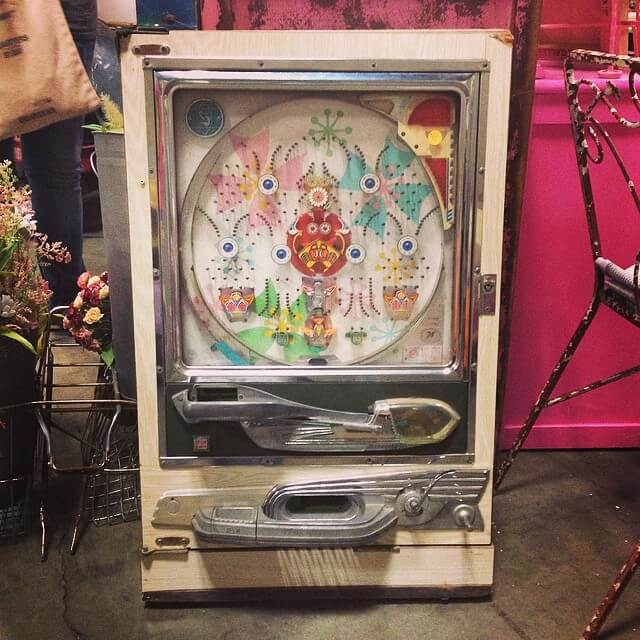Pachinko, the vibrant and electrifying game that has captured the hearts of millions in Japan, holds a significant place in the country’s culture. Combining the elements of a pinball machine and a slot machine, pachinko is not merely a game of chance but a subculture in itself. In this article, we delve into the world of pachinko, exploring its origins, mechanics, and the captivating sound and light experience that makes it a truly unique phenomenon in retro Japan.
Origins of Pachinko
Pachinko’s origins can be traced back to the early 1920s when it emerged as a children’s game called “korinto gemu.” The game involved shooting marbles into a wooden board filled with nails. However, it wasn’t until after World War II that pachinko gained immense popularity among adults.

“Whispers of the Past: A Retro Pachinko’s Enduring Legacy.”
Image Credit: Makely
Influenced by the introduction of pinball machines from the West, pachinko machines were created as a fusion of entertainment and gambling. However, the first modern pachinko machine was developed by Masamura Takeichi in 1929. Over time, pachinko machines evolved, incorporating innovations such as electrical components and the use of small metal balls.
During the post-war era, Japan experienced an economic boom, and pachinko parlours began to spring up across the country. These parlours provided a recreational outlet for the masses and offered an escape from the hardships of daily life. Pachinko became more than just a game; it became a cultural phenomenon that captured the spirit of a nation rebuilding itself.
Mechanics of Pachinko
Pachinko machines may seem intricate, but their mechanics follow a simple principle. Players launch small metal balls into a vertical playing field filled with pins, obstacles, and scoring pockets. The objective is to skillfully aim the balls, hoping they land in specific pockets to trigger various actions and increase the chances of winning more balls.

A pachinko parlour in Asakusa, Japan
Image Credit: Business Insider
As players release the balls into the machine, they cascade down the playing field, bouncing off the pins and creating a symphony of sounds. Morover the captivating clinks, clanks, and pings reverberate throughout the pachinko parlour, enhancing the excitement and drawing players deeper into the game. The visual spectacle is equally mesmerizing, with flashing lights and dynamic visual displays accompanying the gameplay.
Pachinko machines employ a variety of mechanisms to keep players engaged. Some machines feature obstacles that change the trajectory of the balls, creating an element of unpredictability. Others incorporate features such as spinning reels or gates that open and close, providing additional opportunities for winning. The skill lies in mastering the timing and aim required to achieve desired outcomes.
Immersing oneself in a pachinko parlour is an assault on the senses. The rows upon rows of machines create a kaleidoscope of colour, and the air is filled with an energetic symphony of sounds. Each machine has its unique soundtrack, composed of jingles, melodies, and sound effects that add to the overall sensory experience.
Flashing lights, neon signs, and vibrant displays envelop the players, transporting them to a world where time stands still. The rhythmic beat of balls hitting the pins creates a hypnotic backdrop, enhancing the suspense and anticipation of every play. The combination of visual and auditory stimuli in a pachinko parlour creates an immersive environment that is unparalleled in the realm of gaming.
The sound and light experience in pachinko parlours is carefully designed to heighten the excitement and engagement of players. The flashing lights are strategically positioned to draw attention to certain areas of the machine, indicating potential winning opportunities. The sound effects are carefully crafted to create a sense of reward and satisfaction, further fueling the desire to continue playing.
The Subculture of Pachinko
Pachinko has evolved beyond being just a game; it has become a subculture in Japan. Pachinko parlours are not merely places to play; they are social hubs where players come together to connect, share experiences, and enjoy the camaraderie of fellow enthusiasts.
These establishments often feature amenities such as comfortable lounges, cafes serving refreshments, and even restaurants, providing a space for players to relax and socialize. Pachinko parlours have become a place where people from different walks of life converge, united by their love for the game.
This exhibition’s deconstructed patch jacket demonstrates how menswear fashion trends are created. By refusing to appear seamless, the jacket breaks the traditional business suit. Patches of several suiting fabric types appear to run in various directions. Every seam and thread as well as every fabric fragment are visible in the designer’s garment.

Pachinko Parlour in Cyberpunk 2077
Image Credit: Cyberpunk 2077 Wiki
Pachinko, with its fusion of skill, chance, and sensory immersion, remains a vibrant subculture in retro Japan. Its origins, mechanics, and captivating sound and light experience have solidified its place in Japanese society. Finally, the pachinko parlours continue to be thriving social spaces where people can indulge in the excitement of the game. All while forging connections with fellow enthusiasts. As the subculture of pachinko evolves, it continues to enchant and enthral. Keeping the spirit of retro Japan alive in the modern era.










































